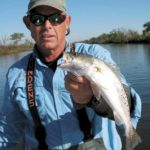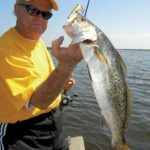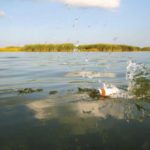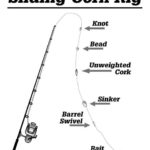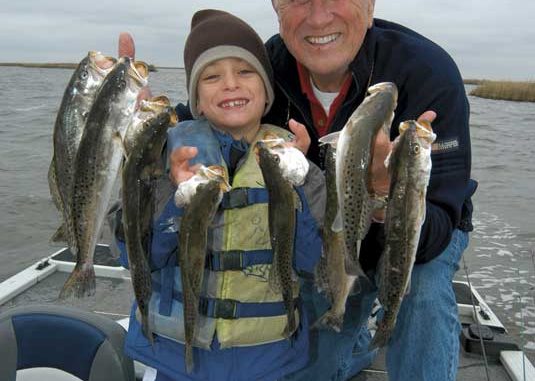
The fish are thick in this annual hotspot, but they aren’t exactly snug on the bottom.
“Why don’t you and your brother come fishing with us Monday?” the voice on the phone said. “Monday is New Year’s Eve, and isn’t it supposed to be cold?” I asked.
Actually, I knew the answer before I asked. It was supposed to be sunny, but the first real bone-chilling cold front was predicted to move through by that night, and then the thermometer would go south from there until it registered what would be the coldest temperatures of the season.
“We’re on a real good winter bite right now, and we thought you might want to jump on it before the real cold weather gets here,” the voice enticed. “We’ll do an early morning trip and wrap up by noon. We’ll beat the worst of the cold, and you’ll have plenty time to get home for the New Year’s Eve festivities.”
“We’ll be there,” I said.
And we were. And it was cold!
The voice belonged to an old friend and part owner of Hopedale’s Breton Sound Marina, Glenn Sanchez. He and his son Jonathan had the boat ready at the dock, and it was a quick matter of throwing our stuff aboard, donning gloves and hats and zipping up our jackets for the ride.
“Where we headed?” I asked as we putted toward the MRGO.
“You won’t have any trouble figuring this out,” the elder Sanchez said. “We’ll be fishing in Bayou La Loutre, doing the old Doodie Drift.”
He was referring to a technique commonly called the La Loutre Drift, popularized by Leon “Doodie” Chaplain, one of the former owners of the marina, who liked to simply drift the back section of Bayou La Loutre during the winter season and bounce baits off the bottom and down the ledges.
We’ve done several articles on the technique and Bayou La Loutre over the past dozen years, including one last month, so the spot and the method would follow a familiar routine. I knew we’d head to the section of the bayou between Isaac’s Ditch and Stump Lagoon, and drop the trolling motor. I knew we’d use it just enough to keep the boat properly positioned, and I knew we’d drop a drift sock over to slow down our drift if necessary. I wasn’t disappointed to learn of our destination because we usually do well there, and with Jonathan at the helm, I was confident we’d catch some fish.
The first surprise of the day came when I prepared to make my first cast. I had a Hybrid plastic on a ¼-ounce jig, and was planning to toss it out and tightline it off the bottom when I heard something I wasn’t expecting.
“We’re going to be fishing under a cork today,” Jonathan said.
At first I thought he was joking.
“Ha ha. Good one, Jonathan. Fishing under a cork in this cold weather,” I thought to myself.
But he wasn’t joking. He had a spinning reel rigged up with PowerPro line, and a Hybrid lure in the magic minnow color dangled on a ¼-ounce jig on the end of the line. And about 5 feet above the lure he snapped on a fat, red, oval cork, and tossed it out.
“The fish have been hanging along the drop-offs,” he said. “When the temperatures drops to real cold and stay there for a day or two, you’ll probably catch more off the bottom. But just before a front or a few days after, once temperatures moderate, they hang on the ledges, and it doesn’t really matter what side of the bayou you fish because they are hanging on both sides.”
He popped the cork steadily, just like you would in the spring, and within a minute after casting, his cork vanished beneath the surface.
The first fish of the morning was slightly undersized, and then we caught a flurry of same-sized fish in rapid succession. I caught a few tightlining, and Glenn caught a few on a 52M MirrOlure, but the bait that out produced us all was hanging under that popping cork.
We moved about a quarter-mile farther up the bayou to try to find some bigger fish. This time the young Sanchez caught fish repeatedly, and these were keeper size. I figured I could catch just as many tightlining off the bottom, so I stuck with it. Glenn was as hardheaded as I was, and for a long time wouldn’t get off that MirrOlure until he finally became exasperated watching his offspring catch all the fish, and switched to a cork.
Meanwhile, my brother was duplicating the young Sanchez’s technique from off the back deck. And these bigger trout totally ignored my bottom lure. I dragged it, bounced it, dribbled it down one side of the bayou and then the other, switched colors, switched to a curly tail, all to no avail.
“It’s really been different this year,” Jonathan said. “When I’ve fished this very same area tightlining off the bottom, I’ve managed to land a few fish, and sometimes even more than a few. But when I put on a cork and fish between 4 and 5 feet deep, I’ve been putting a spanking on them.”
The second surprise of the day was the tremendous amount of boat traffic back and forth in the bayou. I know you have to expect traffic in such a main bayou as La Loutre, but the sheer amount of boats on the water was an unexpected sight. And most of them were trying to fish in the bayou.
“I’m shocked to see this,” the young Sanchez said. “I’ve fished out here all week long, and the only other boats I’ve seen fishing in the bayou were a couple other guides. All the rest of the traffic has been heading up into Stump Lagoon and points beyond, leaving the bayou to us. But the word must have gotten out somehow.”
“Yeah, probably somebody posted a report on the internet. That’s all it takes is one report, and the place will be swarming with boats,” the elder Sanchez said.
The problem was that just when you’d get on a good bite, a boat would pass and shut the action down again. Or just as your drift started to produce, you’d have to maneuver around some other boat that was either anchored or trolling the opposite way.
Frustrated by the sheer number of boats in that section of the bayou and a few incredibly inconsiderate (or plain ignorant) boaters who don’t know you are supposed to slow down enough not to throw a huge wake, Jonathan fired up the outboard to hunt for an empty stretch of bayou.
“The fish are all up and down the bayou,” he said. “On days with not much tide movement, I fish near the major cuts and intersections where I can find some moving water. On days with a lot of tide, I move away from the cuts to longer sections of the bayou without intersections, where the tide moves slower and the fish are more likely to bite.”
We settled into a stretch of bayou where few other boats were in sight, and almost immediately resumed catching fish. Well, to be perfectly honest, Jonathan resumed catching fish. He plopped one trout into the ice chest after the other. I finally succumbed to the inevitable, and switched over to a cork rig set about 3 feet deep.
“Not deep enough,” Jonathan said, as I tossed out and started popping it like it was summer.
After a few more fruitless casts, I set the cork down to about 4 feet, and tried again.
And Jonathan kept reeling them in.
“You can drift and troll with the tide and successfully catch fish, or you can do what we’re doing right now, troll against the tide, so when you cast out and pop your cork and slowly reel in, you’re actually swimming your bait in the same direction the tide is moving, which makes for a more natural presentation,” he said. “Of course, when the tide is running hard, you have no choice but to drift with it.”
“Blah, blah, blah,” I thought to myself, trying to figure out why these blasted trout wouldn’t hit my cork rig, but they wouldn’t leave young Sanchez’s alone. We were fishing the same bait, on the same kind of line, all under a popping cork, but he had all the bites.
I finally looked close enough to discover that he was fishing between 5 to 6 feet under the cork, 2 whole feet deeper than I was fishing, and that had to be the difference. My brother and I both went deeper under the cork, and tried that.
The elder Sanchez was now alternating between casting a MirrOlure toward the bank and catching nothing, and tightlining off the back of the boat, bouncing his bait off the bottom and catching one every now and then. He was reduced to just shaking his head as his son reeled in fish after fish.
Then came my third surprise of the day — just how difficult it is to cast out a line rigged 6 feet under a cork. You need a whole lot of room to do the big swing necessary to make a decent cast. The difficulty is compounded by the number of other anglers in the boat, all attempting the big swing, and you also have to be aware of everything behind you as well.
My brother Tony and I snagged everything in the boat including rods and grab rails, and once I even clubbed Jonathan in the back with my jighead.
But when we managed to cast to the ledges and pop our corks, we got hits. At first we couldn’t seem to hook anything. Our corks would disappear, we’d take up the slack and set the hook and … nothing. They’d knock, we’d answer the door, but nobody was home.
After observing that process repeated about a half-dozen times, Jonathan offered some advice.
“Don’t reel in when your cork goes under,” he said. “Quit trying to reel in the slack before you set the hook; just set the hook and then reel in. Don’t worry about the slack.”
We tried that, and finally started to find some success. In fact, we started catching fish just at the exact time the boat parade resumed in that stretch of the bayou.
The good thing was that a passing boat here and there didn’t entirely shut down the action. A boat would pass, and we often caught fish as they passed or right afterward. But a whole parade of passing boats definitely shut us down, especially the goof balls throwing enough wake to swamp a flatboat.
Jonathan kept us moving. If one spot was slow, we moved. If one section was too crowded, we moved. We roamed up and down the length of Bayou La Loutre from Engineer’s Canal to Bakers Canal, and almost everywhere we drifted we caught something. We never left Bayou La Loutre, and we never stopped drifting and trolling.
I made a mental note to come back and do this again with a sliding-cork rig, which should be much easier to cast.
We headed back to the dock with a couple limits of speckled trout and a new twist for the La Loutre drift.
Capt. Jonathan Sanchez can be reached at (504) 232-6227.

